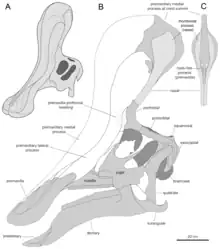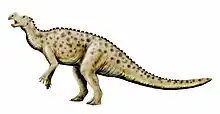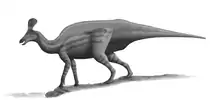Tsintaosaurini
Tsintaosaurini is a tribe of basal lambeosaurine hadrosaurs native to Eurasia. It is thought to contains the genera Tsintaosaurus (from China), Pararhabdodon (from Spain) and Koutalisaurus (also from Spain),[1] though some studies have questioned its existence as a natural grouping.[2]
| Tsintaosaurini Temporal range: Late Cretaceous, | |
|---|---|
 | |
| Educated reconstruction of the skull of Tsintaosaurus spinorhinus | |
| Scientific classification | |
| Domain: | Eukaryota |
| Kingdom: | Animalia |
| Phylum: | Chordata |
| Clade: | Dinosauria |
| Clade: | †Ornithischia |
| Clade: | †Ornithopoda |
| Family: | †Hadrosauridae |
| Subfamily: | †Lambeosaurinae |
| Tribe: | †Tsintaosaurini Prieto-Márquez et al., 2013 |
| Type species | |
| †Tsintaosaurus spinorhinus Young, 1958 | |
| Genera | |
Classification
Tsintaosaurini is part of the family Hadrosauridae, specifically the subfamily Lambeosaurinae.[2][3] The existence of a tsintaosaur clade of lambeosaurines was first recognized by palaeontologists Albert Prieto-Márquez and Johnathan R. Wagner, who in 2009 published a paper recognizing a phylogenetic relationship between Tsintaosaurus and Pararhabdodon based both on shared anatomical traits and a phylogenetic analysis.[4] A 2013 study by Prieto-Márquez corroborated the existence of this grouping, and coined the tribe Tsintaosaurini to refer to it. The type genus is Tsintaosaurus, and it was defined as the smallest clade containing Tsintaosaurus spinorhinus and Pararhabdodon isonensis.[3] Several studies since have corroborated the existence of the clade,[2][5][6] though some others have failed to recover it, instead finding the two genera in a polytomy of basal lambeosaurs.[2][7][8] A 2021 paper by Daniel Madzia and other ornithischian researchers, focused on a revising ornithischian nomenclature and converting existing group names into Phylocode-compliant clades, re-formalized the coining of Tsintaosaurini and revised its definition to be the most inclusive group including T. spinorhinus and P. isonensis, but not Aralosaurus tuberiferus, Lambeosaurus lambei, or Parasaurolophus walkeri.[2] The following cladogram shows the results of a phylogenetic analysis of hadrosaur relationships from a 2022 study:[9]
| Hadrosauridae |
| ||||||||||||||||||||||||||||||||||||||||||||||||||||||||||||||||||||||||||||||
A 2020 study by Nick Longrich and colleagues describing the genus Ajnabia found Pararhabdodon to be part a monophyletic clade of European lambeosaurs, termed Arenysaurini, rather than a relative of Tsintaosaurus, thereby making the tribe an inapplicable polyphyletic grouping. The cladogram from their study's phylogenetic analysis is shown below:[2][10]
| Hadrosauridae |
| ||||||||||||||||||||||||||||||||||||||||||||||||||||||||||||||||||||||||||||||||||||||||||
See also
References
- Prieto-Márquez, Albert; Dalla Vecchia, Fabio M.; Gaete, Rodrigo; Galobart, Àngel (2013). "Diversity, Relationships, and Biogeography of the Lambeosaurine Dinosaurs from the European Archipelago, with Description of the New Aralosaurin Canardia garonnensis". PLOS ONE. 8 (7): e69835. Bibcode:2013PLoSO...869835P. doi:10.1371/journal.pone.0069835. PMC 3724916. PMID 23922815.
- Madzia, D.; Arbour, V.M.; Boyd, C.A.; Farke, A.A.; Cruzado-Caballero, P.; Evans, D.C. (2021). "The phylogenetic nomenclature of ornithischian dinosaurs". PeerJ. 9: e12362. doi:10.7717/peerj.12362. PMC 8667728. PMID 34966571.
- Prieto-Márquez, A.; Dalla Vecchia, F. M.; Gaete, R.; Galobart, À. (2013). "Diversity, Relationships, and Biogeography of the Lambeosaurine Dinosaurs from the European Archipelago, with Description of the New Aralosaurin Canardia garonnensis" (PDF). PLOS ONE. 8 (7): e69835. Bibcode:2013PLoSO...869835P. doi:10.1371/journal.pone.0069835. PMC 3724916. PMID 23922815.
- Prieto-Márquez, A.; Wagner, J.R. (2009). "Pararhabdodon isonensis and Tsintaosaurus spinorhinus: a new clade of lambeosaurine hadrosaurids from Eurasia" (PDF). Cretaceous Research. online preprint (5): 1238. doi:10.1016/j.cretres.2009.06.005. hdl:2152/41080. S2CID 85081036.
- McDonald, A. T.; Wolfe, D. G.; Freedman Fowler, E. A.; Gates, T. A. (2021). "A new brachylophosaurin (Dinosauria: Hadrosauridae) from the Upper Cretaceous Menefee Formation of New Mexico". PeerJ. 9: e11084. doi:10.7717/peerj.11084. PMC 8020878. PMID 33859873.
- Kobayashi, Y.; Takasaki, R.; Kubota, K.; Fiorillo, A. R. (2021). "A new basal hadrosaurid (Dinosauria: Ornithischia) from the latest Cretaceous Kita-ama Formation in Japan implies the origin of hadrosaurids". Scientific Reports. 11 (1): Article number 8547. Bibcode:2021NatSR..11.8547K. doi:10.1038/s41598-021-87719-5. PMC 8076177. PMID 33903622.
- Prieto-Márquez, Albert; Fondevilla, Víctor; Sellés, Albert G.; Wagner, Jonathan R.; Galobart, Àngel (2018). "Adynomosaurus arcanus, a new lambeosaurine dinosaur from the Late Cretaceous Ibero-Armorican Island of the European Archipelago". Cretaceous Research. 96: 19–37. doi:10.1016/j.cretres.2018.12.002. S2CID 134582286.
- Gates, Terry A.; Evans, David C.; Sertich, Joseph J.W. (2021). "Description and rediagnosis of the crested hadrosaurid (Ornithopoda) dinosaur Parasaurolophus cyrtocristatus on the basis of new cranial remains". PeerJ. 9: e10669. doi:10.7717/peerj.10669. PMC 7842145. PMID 33552721.
- Ramírez-Velasco, Angel Alejandro (2022). "Phylogenetic and biogeography analysis of Mexican hadrosauroids". Cretaceous Research. 138: 105267. doi:10.1016/j.cretres.2022.105267. S2CID 249559319.
- Longrich, Nicholas R.; Suberbiola, Xabier Pereda; Pyron, R. Alexander; Jalil, Nour-Eddine (2020). "The first duckbill dinosaur (Hadrosauridae: Lambeosaurinae) from Africa and the role of oceanic dispersal in dinosaur biogeography". Cretaceous Research. 120: 104678. doi:10.1016/j.cretres.2020.104678. S2CID 228807024.







